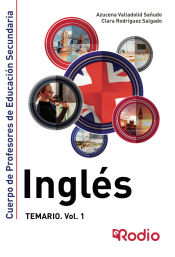Libro

Inglés. Temario. Volumen 1. Cuerpo de Profesores de Educación Secundaria.
- Ediciones Rodio
- Ediciones Rodio
- (10/2019)
- 482 páginas;
- ISBN-13: 9788417661885
Resumen:
Este libro presenta un temario renovado destinado a los aspirantes al Cuerpo de Profesores de Educación Secundaria de la especialidad de Inglés, elaborado de tal modo que no solo sirve para el desarrollo escrito del tema, sino que además resulta útil para abordar la parte práctica de la prueba. De hecho, el empleo de una estructura común en todos los temas, así como la incorporación de epígrafes clave y un espíritu sintetizador, es lo que otorga un carácter distintivo a este temario. Igualmente, este volumen incluye una descripción del temario que señala sus rasgos esenciales, teniendo en cuenta los aspectos relevantes que los tribunales valoran a la hora de calificar el examen, ya que las autoras han pasado por dicho proceso y lo han escrito basándose en su experiencia personal con el fin de ayudar a los opositores en el proceso selectivo.
Este libro presenta un temario renovado destinado a los aspirantes al Cuerpo de Profesores de Educación Secundaria de la especialidad de Inglés, elaborado de tal modo que no solo sirve para el desarrollo escrito del tema, sino que además resulta útil para abordar la parte práctica de la prueba. De hecho, el empleo de una estructura común en todos los temas, así como la incorporación de epígrafes clave y un espíritu sintetizador, es lo que otorga un carácter distintivo a este temario. Igualmente, este volumen incluye una descripción del temario que señala sus rasgos esenciales, teniendo en cuenta los aspectos relevantes que los tribunales valoran a la hora de calificar el examen, ya que las autoras han pasado por dicho proceso y lo han escrito basándose en su experiencia personal con el fin de ayudar a los opositores en el proceso selectivo.
Indice:
Theme 1. The evolution of language teaching. Contemporary trends in the teaching of English as a foreign language. The Communicative Approach.
Theme 2. General theories of foreign language learning and acquisition. The concept of interlanguage. The treatment of error.
Theme 3. The communication process. The functions of language. Language in use. Negotiation of meaning The communication process. The functions of language. Language in use. Negotiation of meaning.
Theme 4. Communicative competence. Analysis of its components.
Theme 5. Oral communication. Elements and rules governing oral discourse. Routines and formulas. Strategies of oral communication.
Theme 6. Written communication. Different types of written texts. Structure and formal elements. Norms of written texts. Routines and formulas.
Theme 7. The English phonological system i: the vowels and their phonetic symbols. Weak and storng forms. Diphthongs and their phonetic symbols. Comparison of the English and Spanish phonological system.
Theme 8. The English phonological system ii: the consonants and their phonetic symbols. Comparison of the English and Spanish phonological system.
Theme 9. The English phonological system iii: accent, rhythm and intonation. Comparison of the English and Spanish phonological system.
Theme 10. Lexicon: characteristics of word-formation in English. Prefixation, suffixation and compounding .
Theme 11. The word as a linguistic sign. Homonymy. Synonymy. Antonymy. False friends. Lexical creativity.
Theme 12. The concept of grammar: reflections on language and language learning. From normative grammar to grammar according to language use and communication.
Theme 13. The expression of quantity.
Theme 14. The expression of quality. The expression of degree and comparison.
Theme 15. The expression of manner, means and instrument.
Theme 16. The expression of possesion.
Theme 17. Position in space. Place, direction and distance.
Theme 18. Position in time. Temporal relationships. Frequency.
Theme 19. Time, tense, aspect and mood.
Theme 20. Auxiliary and modal verbs. Form and function.
Theme 21. The infinitive and the –ing form: their uses.
Theme 22. Multi-word verbs.
Theme 23.Sentence structure in English: declaratives, interrogatives,negatives and exclamations.
Theme 24. The expression of assertion, emphasis and objection.
Theme 25. Reason, result and purpose relationships.
Theme 26. The expression of doubt, condition, hypothesis and contrast.
Theme 27. The passive voice. Forms and uses.
Theme 28. Linguistic macrofunctions to express the most common communicative intentions: to establish and keep social relationships, to give and ask for information about things, people and actions, to express intellectual and emotional attitudes.
Theme 29. Discourse analysis. Cohesion and coherence. Anaphora and cataphora. Connectors. Deixis.
Theme 30. Direct and indirect speech.
Theme 31. Text and context. Types of texts. Criteria for the classification of text types. Register
Theme 32. The narrative text: structure and characteristics.
Theme 33. The descriptive text: structure and characteristics.
Theme 34. Argumentative texts: structure and characteristics.
Theme 1. The evolution of language teaching. Contemporary trends in the teaching of English as a foreign language. The Communicative Approach.
Theme 2. General theories of foreign language learning and acquisition. The concept of interlanguage. The treatment of error.
Theme 3. The communication process. The functions of language. Language in use. Negotiation of meaning The communication process. The functions of language. Language in use. Negotiation of meaning.
Theme 4. Communicative competence. Analysis of its components.
Theme 5. Oral communication. Elements and rules governing oral discourse. Routines and formulas. Strategies of oral communication.
Theme 6. Written communication. Different types of written texts. Structure and formal elements. Norms of written texts. Routines and formulas.
Theme 7. The English phonological system i: the vowels and their phonetic symbols. Weak and storng forms. Diphthongs and their phonetic symbols. Comparison of the English and Spanish phonological system.
Theme 8. The English phonological system ii: the consonants and their phonetic symbols. Comparison of the English and Spanish phonological system.
Theme 9. The English phonological system iii: accent, rhythm and intonation. Comparison of the English and Spanish phonological system.
Theme 10. Lexicon: characteristics of word-formation in English. Prefixation, suffixation and compounding .
Theme 11. The word as a linguistic sign. Homonymy. Synonymy. Antonymy. False friends. Lexical creativity.
Theme 12. The concept of grammar: reflections on language and language learning. From normative grammar to grammar according to language use and communication.
Theme 13. The expression of quantity.
Theme 14. The expression of quality. The expression of degree and comparison.
Theme 15. The expression of manner, means and instrument.
Theme 16. The expression of possesion.
Theme 17. Position in space. Place, direction and distance.
Theme 18. Position in time. Temporal relationships. Frequency.
Theme 19. Time, tense, aspect and mood.
Theme 20. Auxiliary and modal verbs. Form and function.
Theme 21. The infinitive and the –ing form: their uses.
Theme 22. Multi-word verbs.
Theme 23.Sentence structure in English: declaratives, interrogatives,negatives and exclamations.
Theme 24. The expression of assertion, emphasis and objection.
Theme 25. Reason, result and purpose relationships.
Theme 26. The expression of doubt, condition, hypothesis and contrast.
Theme 27. The passive voice. Forms and uses.
Theme 28. Linguistic macrofunctions to express the most common communicative intentions: to establish and keep social relationships, to give and ask for information about things, people and actions, to express intellectual and emotional attitudes.
Theme 29. Discourse analysis. Cohesion and coherence. Anaphora and cataphora. Connectors. Deixis.
Theme 30. Direct and indirect speech.
Theme 31. Text and context. Types of texts. Criteria for the classification of text types. Register
Theme 32. The narrative text: structure and characteristics.
Theme 33. The descriptive text: structure and characteristics.
Theme 34. Argumentative texts: structure and characteristics.
Este libro pertenece a la colección:
Inglés. Cuerpo de Profesores de Educación Secundaria - Ediciones Rodio

Libros que incluye el temario
- Inglés. Temario. Volumen 1. Cuerpo de Profesores de Educación Secundaria.
- Inglés. Temario. Volumen 2. Cuerpo de Profesores de Educación Secundaria.
Actualizado en Octubre de 2019
¡Suscríbete a nuestra newsletter!
Suscríbete a nuestras newsletters y estarás informado de nuevos contenidos útiles y temarios para preparar tus oposiciones y de nuevas convocatorias.
Temarios Oposiciones Destacadas
Últimas Oposiciones
- Enfermero/a del Servicio Gallego de Salud (SERGAS)
- Facultativo Especialista de Área del Servicio de Salud de las Islas Baleares (IB-SALUT)
- Enfermero/a Especialista en Enfermería Familiar y Comunitaria del Servicio Gallego de Salud (SERGAS)
- Médicos de familia (EAP) del Servicio de Salud de las Islas Baleares (IB-SALUT)
- Enfermero/a Especialista en Enfermería Obstétrico Ginecologica del Servicio Gallego de Salud (SERGAS)
Últimas noticias
- Instituto Catalán de la Salud. Aprobada OEP 2019 con 1.207 plazas diversas categorías
- Servicio Murciano de Salud (SMS). Aprobada OEP 2019 con 543 plazas diversas categorías
- Canarias. Aprobada OEP 2019 con 908 plazas de diversas categorías de la Administración General y Servicio Canario de Salud (SCS)
- Galicia. Aprobada OEP 2019 con 2.316 plazas personal docente
- Servicio Andaluz de Salud (SAS). Aprobada OEP 2019 con 3.536 plazas Más noticias
Política de privacidad
Copyright © Agapea Factory S.A 2025
Copyright © Agapea Factory S.A 2025

